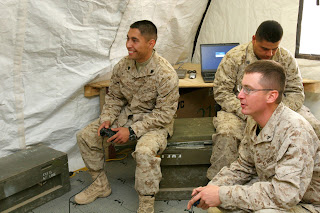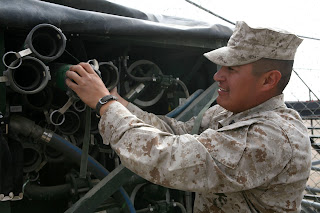
Date written: Feb. 13, 2009
Story by Lance Cpl. Ronald W. Stauffer
FARAH PROVINCE, Islamic Republic of Afghanistan – The term “man hunt” would only come close to describing the dedication Combat Logistics Battalion 3 put forth recently to ensure Sgt. Patrick D. Allan had the opportunity to re-enlist in the U.S. Marine Corps.
Currently forward deployed to the Islamic Republic of Afghanistan as an individual augment with Support Company, CLB-3, Allan, a Camp Pendleton, Calif.-based tank crewman, got a shocking wake-up call the morning of Jan. 8, 2009.
When a loud banging noise from outside the 22-year-old sergeant’s M88 tank retriever woke him, he never would have thought it would be for his re-enlistment ceremony, which was held at Combat Outpost Barrow in Farah Province.
Not more than a week earlier, Allan almost lost his re-enlistment opportunity after the deadline to “re-up” for the last remaining boat space, or opening, in his occupational field had expired while Allan was out in the field supporting an operation. Because of the circumstances, Allan’s chain of command was able to go to bat for him, receiving an extension for Allan’s re-enlistment authority from the Marine

Manpower Enlisted Assignments Branch at Headquarters U.S. Marine Corps in Washington.
“The first thing we did was ask Gunnery Sergeant Michael Peck, the career retention specialist for CLB-3, himself located at CLB-3’s home base in Kaneohe Bay, Hawaii, to contact Headquarters Marine Corps and ask for more time,” said Sgt. Maj. Danny D. Duvall, CLB-3’s sergeant major. “It was granted and authorized to be modified to no later than Jan. 8.”
The extension of the re-enlistment deadline came as a relief, but the battalion had one other small issue – Allan was not at the battalion headquarters’ present location of Camp Barber in Helmand Province. Instead, he was on a combat logistics patrol supporting Operation Gateway III, which had the battalion widely dispersed across Farah Province

to the west. To complicate matters, CLB-3’s headquarters had a difficult time contacting Allan due to the nature of the fast-moving operation.
While CLB-3 attempted to get a message to the sergeant, Peck, from his office in Hawaii, was hard at work e-mailing Duvall line-by-line directions on how to fill out the paperwork for the $52,000 bonus Allan would eventually receive.
Duvall used time zones to his advantage and e-mailed the 1st Marine Division sergeant major on the West Coast at Camp Pendleton after the work day had ended on the East Coast.
“I wanted to provide a chain to ensure everything would get done before Allan’s re-enlistment authority expired,” he said.

Duvall explained that he contacted the division sergeant major for “extra fire support” and to let him know that one of his Marines was here trying to re-enlist and that it would be difficult because Allan was out supporting an operation.
Working diligently throughout the night, CLB-3’s combat operations center exchanged faxes with three offices in the U.S. and established communications with the combat logistics patrol through the battalion’s combat operations center around 11 p.m., Jan. 7 to locate Allan.
During the night, Marines closest to Allan’s location were informed of the situation but said they wouldn’t be able to reach Allan until later the next morning on Jan. 8.
The battalion’s COC relayed messages to an onboard vehicle communications system to 2nd Lt. Juliann C. Naughton, commander of 2nd Platoon, Motor Transportation Co., CLB-3, stressing the importance of the situation and later even providing the text of the oath of enlistment in order for Naughton to re-enlist Allan.
Naughton immediately took action and found Allan, who was sleeping in his M88 tank retriever.
“We give Marines what they deserve,” Naughton said.
Naughton also said of being out on the patrol for two weeks that there was no better place to have a ceremony than in a combat zone.
Later that morning, Allan stood in front of Naughton with his right hand raised as he echoed the oath of enlistment, while the Marines at Kaneohe Bay, Camp Pendleton, and Headquarters U.S. Marine Corps waited for confirmation of Allan’s re-enlistment. Around 7:30 a.m., the COC received a relieving message from Naughton that served as the source document confirming Allan’s re-enlistment.
“It was like the NASA team celebrating (in the COC),” Duvall said. “We made it, and at that point it was a relay race on how fast we could get information out.”
Immediately upon receiving confirmation, the sergeant major promptly redirected back to e-mails, thanking everyone for their support and effort for the successful re-enlistment.
“I wasn’t aware that I would be re-enlisting that morning, and I was excited,” Allan said. “I was aware of the commitment and dedication on CLB-3’s part that made this re-enlistment happen for me, and I’m grateful that they went the extra mile to help me out.”
Allan said he was unaware that he held the last remaining boat space for his occupational field, and he was extremely pleased with the tax-free bonus he received by re-enlisting.
Duvall said he was relieved to see the re-enlistment unfold successfully and the leaders of the combat logistics patrol maintain the integrity of the re-enlistment process.
“It’s (astounding) how five locations in the world can work together throughout the night to get a Marine sworn in during a combat operation,” Duvall said.
According to Allan’s commanding officer, Lt. Col. Michael Jernigan, CLB-3’s efforts throughout were reflected in its motto “`O Ka Hana, ‘A’ole Ka ‘Olelo, the Hawaiian term meaning “actions, not words.”


 told him, ‘we’d give it a try.’”
told him, ‘we’d give it a try.’”




































